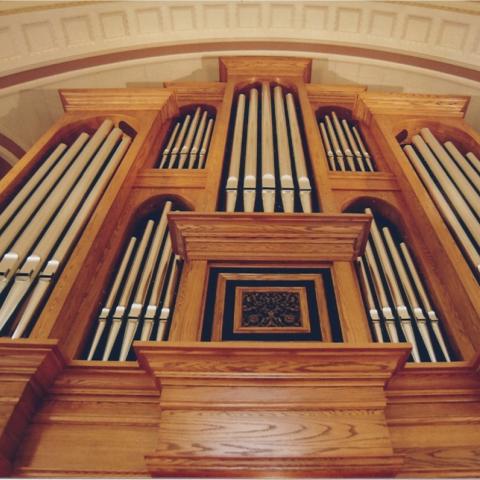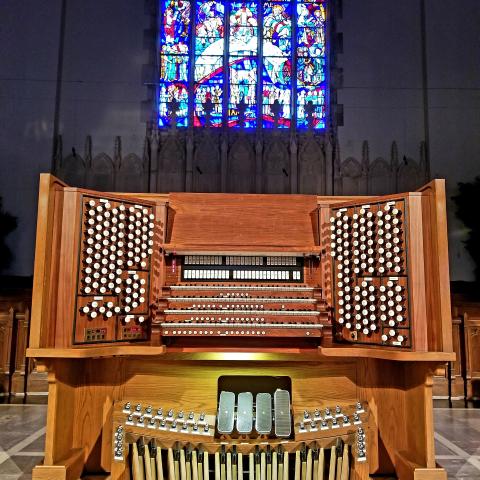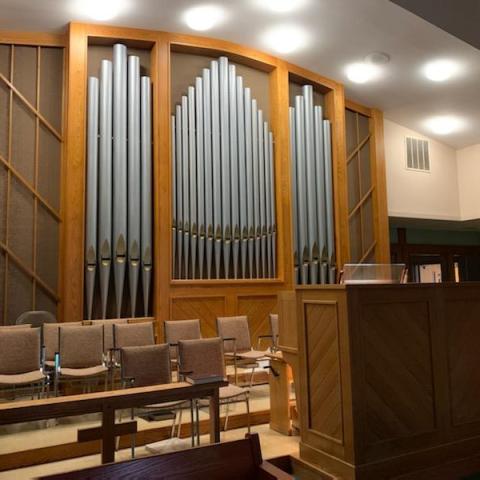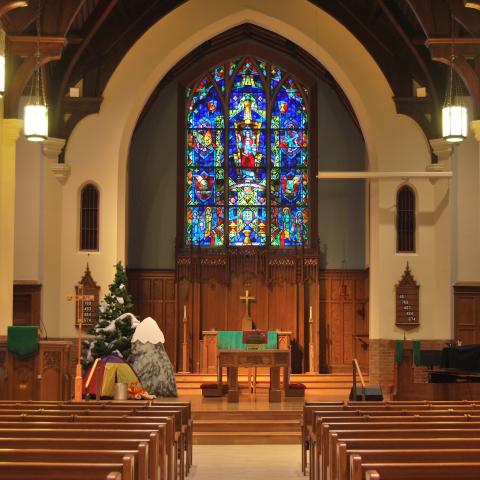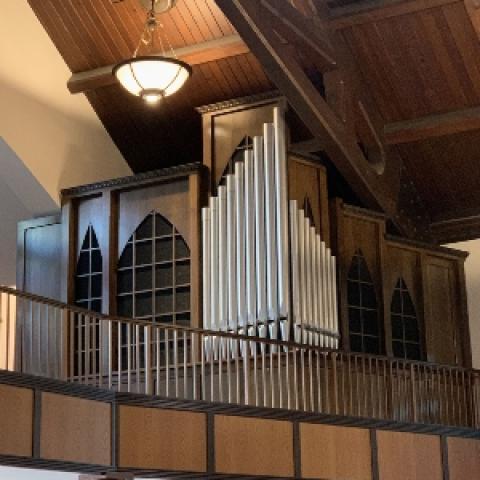Fabry Inc. Pipe Organ Builders,
Antioch, Illinois
Gregory Gyllsdorff residence,
Rockford, Illinois
The 2½ rank all-exposed instrument was built in 1970 by M. P. Möller of Hagerstown, Maryland, as their Opus 10708 and installed at the DeKoven Episcopal Foundation of Racine, Wisconsin. When the Episcopal Foundation closed its doors, the instrument was sold. During the next several years Fabry, Inc., added a swell box and five additional ranks, bringing this instrument to a total of 7½ ranks, a set of chimes, and a Zimbelstern handbell unit. Fabry, Inc., also converted the DC relay system to a Peterson diode matrix system and added a Peterson Single Board Duo-Set combination action.
In 2017, Fabry, Inc., re-engineered the instrument to fit into Gregory Gyllsdorff’s music room, and to save space, installed the blower, wind supply reservoir, and the chamber’s solid state relay on the front wall of the garage. This isolated the equipment and allowed for an air intake from the home for tempered air.
On August 28, 2017, Gyllsdorff entertained the Rockford Chapter of the American Guild of Organists at his home where a blessing was given for the home and the pipe organ.
GREAT
8′ Principal (unenclosed, 61 pipes)
8′ Rohrflute (enclosed, 97 pipes)
4′ Principal (enclosed, 73 pipes)
4′ Rohrflute (ext 8′)
22⁄3′ Twelfth (ext, 4′ Principal)
2′ Rohrflute (ext 8′)
8′ Schalmei (enclosed, 61 pipes)
4′ Schalmei (fr 8′, top octave repeats)
Chimes (21 tubes)
Zimbelstern (5 handbell unit)
Swell to Great
Pedal to Great
MIDI to Great
SWELL
8′ Principal (Gt)
8′ Rohrflute (Gt)
8′ Erzahler (unenclosed, 61 pipes)
8′ Erzahler Celeste (unenclosed, TC,
49 pipes)
4′ Principal (Gt 4′)
4′ Rohrflute (Gt)
22⁄3′ Nazard
2′ Principal (ext Gt 4′)
11⁄3′ Larigot (enclosed, TG, 42 pipes)
8′ Schalmei (Gt)
4′ Schalmei (Gt)
Tremolo (entire organ)
MIDI to Swell
PEDAL
32′ Resultant (Gt 8′ Rohrflute)
16′ Bourdon (ext Gt 8’ Rohrflute)
8′ Principal (Gt)
8′ Rohrflute (Gt)
4′ Choral Bass (Gt 8′ Principal)
32′ Contra Fagotto (wired fr 16′)
16′ Fagotto (32 pipes)
8′ Schalmei (Gt)
4′ Schalmei (Gt)
Great to Pedal 8
Swell to Pedal 8
MIDI to Pedal
Accessories
12 General pistons (thumb and toe)
General Cancel (thumb)
Set (thumb)
Swell to Pedal reversible (thumb and toe)
Great to Pedal reversible (thumb and toe)
Swell to Great reversible (thumb)
Pedal to Great reversible (thumb)
32′ Resultant reversible (toe)
32′ Fagotto reversible (toe)
Zimbelstern reversible (thumb and toe)
Tutti reversible (thumb and toe)
Balanced Swell shoe
Balanced Crescendo shoe
Indicator Lights: Power, Crescendo, Tutti
Chime Volume Control

